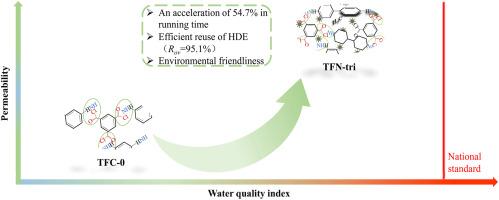三重掺杂纳米复合膜对接近零液体排放的染发废水回收的性能改进。
IF 8.1
2区 环境科学与生态学
Q1 ENVIRONMENTAL SCIENCES
引用次数: 0
摘要
基于预浓缩工具,在不断减少废物流的背景下,提高工业废水回收水平的努力值得期待。为此,通过部分替代掺杂螺状结构的 2,2'-二甲基-1,1'-联苯-4,4'-二胺二盐酸盐和柔性 4,4'-联哌啶基二盐酸盐,并连续加入二硫化钼量子点,成功制备了三重掺杂纳米复合膜(TFN-tri)。在自合成生物可降解絮凝剂预处理的辅助下,原染发废水(HDE)在满足相关国家标准要求的前提下,稳定回收率达95.1%。作为一种深度处理单元,TFN-tri 膜的准确盐排斥率达到了预期的近 66%。更令人印象深刻的是,它的渗透率基本上提高了 2.5 倍,而污垢层厚度、运行时间和比能耗则分别比长期重复使用测试中的同类产品减少了 5 μm、54.7% 和 72.5%。这些变化的主要原因可能是亚纳米孔的细微扩展,加上静电排斥的增强,以及在光滑度和亲水性优化方面的其他关键表层特征所带来的抗污垢能力的提高。简而言之,这项研究为接近液体零排放的重污染高密度聚乙烯再生迈出了坚实可靠的一步。本文章由计算机程序翻译,如有差异,请以英文原文为准。

Performance improvement of triple-doped nanocomposite membrane towards hairwork dyeing effluent reclamation approaching zero liquid discharge
It is highly anticipated that efforts will be made to raise the level of industrial effluent reclamation on the background of continuously minimizing waste stream based on preconcentration tool. For this purpose, a triple-doped nanocomposite (TFN-tri) membrane through partially alternative doping spiro-structured 2,2′-dimethyl-1,1′-biphenyl-4,4′-diamine dihydrochloride and flexible 4,4′-bipiperidyl dihydrochloride and continuous incorporating of molybdenum disulfide quantum dots was successfully fabricated. With the assistance of self-synthesized biodegradable flocculant pretreatment, raw hairwork dyeing effluent (HDE) was stably recycled up to 95.1% on the premise of meeting the requirements of the relevant national standard. As a deep processing unit, TFN-tri membrane displayed accurate salt rejection of nearly 66% as expected. More impressively, it also exhibited permeability basically increased by 2.5 folds, while fouling layer thickness, running time and specific energy consumption decreased by 5 μm, 54.7% and 72.5%, respectively, than its counterpart in long-term reuse testing. These changes may mainly be due to the finely expand sub-nanopores coupled with an enhanced electrostatic exclusion and the improved fouling resistance brought about by other critical skin features in terms of smoothness and hydrophilicity optimization. In brief, this study has taken a vigorous and reliable step towards heavily polluted HDE reclamation approaching zero liquid discharge.
求助全文
通过发布文献求助,成功后即可免费获取论文全文。
去求助
来源期刊

Chemosphere
环境科学-环境科学
CiteScore
15.80
自引率
8.00%
发文量
4975
审稿时长
3.4 months
期刊介绍:
Chemosphere, being an international multidisciplinary journal, is dedicated to publishing original communications and review articles on chemicals in the environment. The scope covers a wide range of topics, including the identification, quantification, behavior, fate, toxicology, treatment, and remediation of chemicals in the bio-, hydro-, litho-, and atmosphere, ensuring the broad dissemination of research in this field.
 求助内容:
求助内容: 应助结果提醒方式:
应助结果提醒方式:


